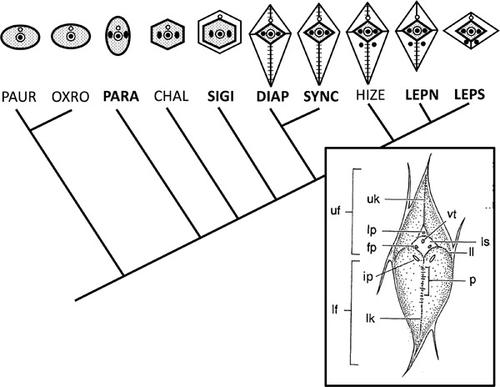当前位置:
X-MOL 学术
›
J. Syst. Evol.
›
论文详情
Our official English website, www.x-mol.net, welcomes your
feedback! (Note: you will need to create a separate account there.)
Better together: Joint consideration of anatomy and morphology illuminates the architecture and life history of the Carboniferous arborescent lycopsid Paralycopodites
Journal of Systematics and Evolution ( IF 3.4 ) Pub Date : 2020-09-21 , DOI: 10.1111/jse.12662 William A. DiMichele 1 , Richard M. Bateman 2
Journal of Systematics and Evolution ( IF 3.4 ) Pub Date : 2020-09-21 , DOI: 10.1111/jse.12662 William A. DiMichele 1 , Richard M. Bateman 2
Affiliation

|
Paralycopodites Morey & Morey, a Carboniferous‐age arboreous lycopsid that grew in the tropical wetlands of Pangea, is the phylogenetically basalmost member of the Carboniferous stigmarian lycopsids to be conceptually reconstructed. We update its description through reciprocal illumination between anatomy (coal‐balls) and gross morphology (adpressions). Revised assessment of its architecture and development shows that the determinate, columnar main trunk eventually underwent several isotomous divisions to form a crown. Two opposite rows of closely‐spaced, compact lateral branches were initiated anisotomously throughout the trunk and crown, each branch further undergoing multiple anisotomous divisions to form an apparently planar scaffold for numerous bisporangiate cones. We infer that branches were initially emitted near‐vertically, but rapidly moved to a more horizontal position; they were abscised after the cones had matured but before the continuous phellogen had produced a centripetal periderm. Leaves were not abscised, though anatomy and morphology both suggest a photosynthetic economy that was localized within the plant body. Character content and clarity of interpretation make Paralycopodites the preferred name for the reconstructed plant rather than Anabathra, Ulodendron, or Bergeria. Phylogenetic analysis of rhizomorphic lycopsids based on a reduced spectrum of features observable in adpression returns the same topology as that based on a full matrix combining both anatomical and externally visible traits, permitting adpression fossils to be assigned to anatomically‐circumscribed genera rather than perpetuating an unnecessary parallel taxonomy.
中文翻译:

更好地结合在一起:解剖学和形态学的共同考虑阐明了石炭纪树状石松石松的结构和生活史
Paralycopodites Morey & Morey 是一种生长在 Pangea 热带湿地的石炭纪树状石松,是石炭纪柱头石松的系统发育最基础的成员,有待概念重建。我们通过解剖结构(煤球)和大体形态(压痕)之间的相互照明来更新其描述。对其结构和发展的修订评估表明,确定的柱状主干最终经历了几次等切分裂以形成冠。两排相对紧密的、紧密的侧枝在整个树干和树冠中不等切地开始,每个分支进一步进行多次不等切的分裂,为许多双孢子囊锥体形成一个明显的平面支架。我们推断分支最初是近乎垂直地发射的,但迅速移动到更水平的位置;它们在锥体成熟后但在连续的腐生菌产生向心周皮之前脱落。叶子没有脱落,尽管解剖学和形态学都表明光合作用经济位于植物体内。字符内容和解释的清晰度使 Paralycopodites 成为重建植物的首选名称,而不是 Anabathra、Ulodendron 或 Bergeria。基于压缩中可观察到的特征的减少谱对根状石蜡的系统发育分析返回与基于结合解剖学和外部可见特征的完整矩阵相同的拓扑结构,允许将压缩化石分配给解剖学上限定的属,而不是使不必要的属永久化平行分类法。
更新日期:2020-09-21
中文翻译:

更好地结合在一起:解剖学和形态学的共同考虑阐明了石炭纪树状石松石松的结构和生活史
Paralycopodites Morey & Morey 是一种生长在 Pangea 热带湿地的石炭纪树状石松,是石炭纪柱头石松的系统发育最基础的成员,有待概念重建。我们通过解剖结构(煤球)和大体形态(压痕)之间的相互照明来更新其描述。对其结构和发展的修订评估表明,确定的柱状主干最终经历了几次等切分裂以形成冠。两排相对紧密的、紧密的侧枝在整个树干和树冠中不等切地开始,每个分支进一步进行多次不等切的分裂,为许多双孢子囊锥体形成一个明显的平面支架。我们推断分支最初是近乎垂直地发射的,但迅速移动到更水平的位置;它们在锥体成熟后但在连续的腐生菌产生向心周皮之前脱落。叶子没有脱落,尽管解剖学和形态学都表明光合作用经济位于植物体内。字符内容和解释的清晰度使 Paralycopodites 成为重建植物的首选名称,而不是 Anabathra、Ulodendron 或 Bergeria。基于压缩中可观察到的特征的减少谱对根状石蜡的系统发育分析返回与基于结合解剖学和外部可见特征的完整矩阵相同的拓扑结构,允许将压缩化石分配给解剖学上限定的属,而不是使不必要的属永久化平行分类法。









































 京公网安备 11010802027423号
京公网安备 11010802027423号